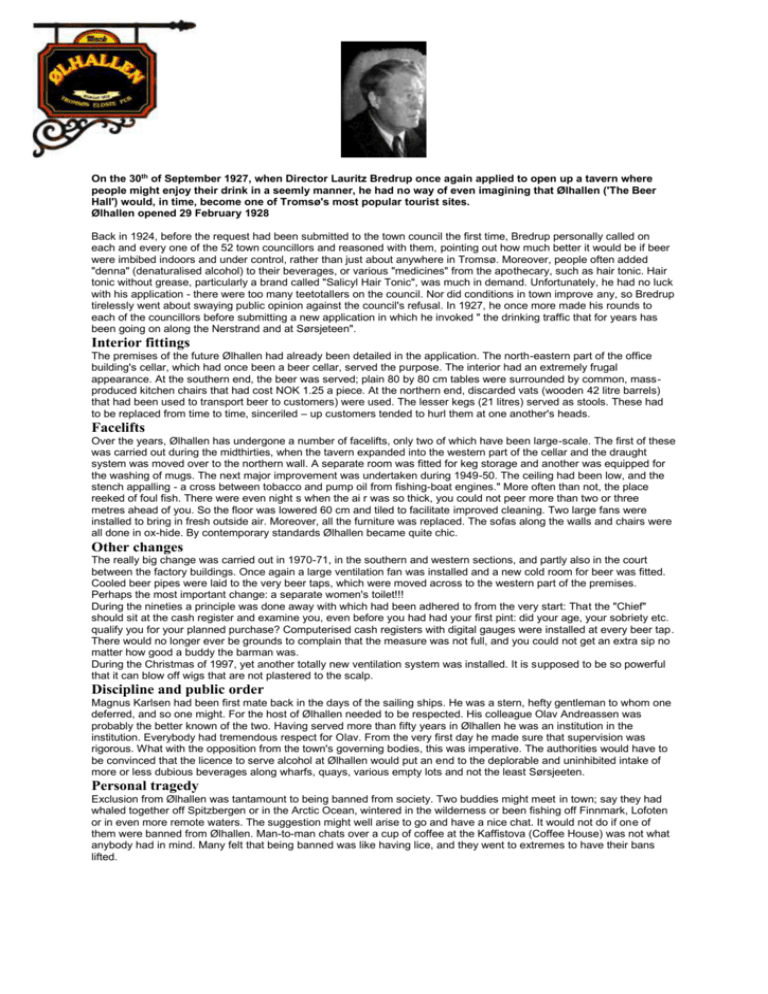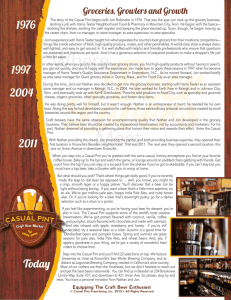The bar-hopping trail
advertisement

On the 30th of September 1927, when Director Lauritz Bredrup once again applied to open up a tavern where
people might enjoy their drink in a seemly manner, he had no way of even imagining that Ølhallen ('The Beer
Hall') would, in time, become one of Tromsø's most popular tourist sites.
Ølhallen opened 29 February 1928
Back in 1924, before the request had been submitted to the town council the first time, Bredrup personally called on
each and every one of the 52 town councillors and reasoned with them, pointing out how much better it would be if beer
were imbibed indoors and under control, rather than just about anywhere in Tromsø. Moreover, people often added
"denna" (denaturalised alcohol) to their beverages, or various "medicines" from the apothecary, such as hair tonic. Hair
tonic without grease, particularly a brand called "Salicyl Hair Tonic", was much in demand. Unfortunately, he had no luck
with his application - there were too many teetotallers on the council. Nor did conditions in town improve any, so Bredrup
tirelessly went about swaying public opinion against the council's refusal. In 1927, he once more made his rounds to
each of the councillors before submitting a new application in which he invoked " the drinking traffic that for years has
been going on along the Nerstrand and at Sørsjeteen".
Interior fittings
The premises of the future Ølhallen had already been detailed in the application. The north-eastern part of the office
building's cellar, which had once been a beer cellar, served the purpose. The interior had an extremely frugal
appearance. At the southern end, the beer was served; plain 80 by 80 cm tables were surrounded by common, massproduced kitchen chairs that had cost NOK 1.25 a piece. At the northern end, discarded vats (wooden 42 litre barrels)
that had been used to transport beer to customers) were used. The lesser kegs (21 litres) served as stools. These had
to be replaced from time to time, sinceriled – up customers tended to hurl them at one another's heads.
Facelifts
Over the years, Ølhallen has undergone a number of facelifts, only two of which have been large-scale. The first of these
was carried out during the midthirties, when the tavern expanded into the western part of the cellar and the draught
system was moved over to the northern wall. A separate room was fitted for keg storage and another was equipped for
the washing of mugs. The next major improvement was undertaken during 1949-50. The ceiling had been low, and the
stench appalling - a cross between tobacco and pump oil from fishing-boat engines." More often than not, the place
reeked of foul fish. There were even night s when the ai r was so thick, you could not peer more than two or three
metres ahead of you. So the floor was lowered 60 cm and tiled to facilitate improved cleaning. Two large fans were
installed to bring in fresh outside air. Moreover, all the furniture was replaced. The sofas along the walls and chairs were
all done in ox-hide. By contemporary standards Ølhallen became quite chic.
Other changes
The really big change was carried out in 1970-71, in the southern and western sections, and partly also in the court
between the factory buildings. Once again a large ventilation fan was installed and a new cold room for beer was fitted.
Cooled beer pipes were laid to the very beer taps, which were moved across to the western part of the premises.
Perhaps the most important change: a separate women's toilet!!!
During the nineties a principle was done away with which had been adhered to from the very start: That the "Chief"
should sit at the cash register and examine you, even before you had had your first pint: did your age, your sobriety etc.
qualify you for your planned purchase? Computerised cash registers with digital gauges were installed at every beer tap.
There would no longer ever be grounds to complain that the measure was not full, and you could not get an extra sip no
matter how good a buddy the barman was.
During the Christmas of 1997, yet another totally new ventilation system was installed. It is supposed to be so powerful
that it can blow off wigs that are not plastered to the scalp.
Discipline and public order
Magnus Karlsen had been first mate back in the days of the sailing ships. He was a stern, hefty gentleman to whom one
deferred, and so one might. For the host of Ølhallen needed to be respected. His colleague Olav Andreassen was
probably the better known of the two. Having served more than fifty years in Ølhallen he was an institution in the
institution. Everybody had tremendous respect for Olav. From the very first day he made sure that supervision was
rigorous. What with the opposition from the town's governing bodies, this was imperative. The authorities would have to
be convinced that the licence to serve alcohol at Ølhallen would put an end to the deplorable and uninhibited intake of
more or less dubious beverages along wharfs, quays, various empty lots and not the least Sørsjeeten.
Personal tragedy
Exclusion from Ølhallen was tantamount to being banned from society. Two buddies might meet in town; say they had
whaled together off Spitzbergen or in the Arctic Ocean, wintered in the wilderness or been fishing off Finnmark, Lofoten
or in even more remote waters. The suggestion might well arise to go and have a nice chat. It would not do if one of
them were banned from Ølhallen. Man-to-man chats over a cup of coffee at the Kaffistova (Coffee House) was not what
anybody had in mind. Many felt that being banned was like having lice, and they went to extremes to have their bans
lifted.
Denied entrance
Early on, the staff designed its own penal code regarding failure to comply with the strict rules. After all, it was not
uncommon to hear strident remonstrations when somebody was denied another glass. The staff would not be moved
and demanded that the belligerent party take off. Should he refuse to leave, he would quite simply be thrown out the
door. The employees had good memories and would recognise him the moment he set foot inside the door again, even
after several months, no matter how sweetly and properly he came to order a pint. Depending on the nature and gravity
of the offence, he might get off with a severe admonition that no recurrence would be tolerated; else he would be
informed that he would be denied entrance for a period of three to twelve months. Moreover, there was a rule according
to which the "landlord himself" - i.e. the licensee - should decide whether the offender should be allowed back in.
Rumour about the rule spread like brushfire through the town, and conduct at Ølhallen became quite decorous.
Forgiveness
Former Managing Director Reinhold Bredrup related that he often received calls from the switchboard about so-and-so
wanting "a little chat" with him. When the caller entered his office, he would beg forgiveness. "Listen, Boss, couldn't you
put in a good word for me, so I can get back into The Hall. Oh, I admit I made a false step, but believe me, it'll never
happen again." Bredrup would promise to present the case to Ølhallen's 'Chief", as Olav came to be known, and that the
caller would be notified. With a "Do what you can, boss", the visitor would leave and Bredrup would phone Olav to see
what he thought. Maybe Olav would say, "We've been keeping him out for so long now, we can take him back in on
probation." Or maybe, "Nah… he's been such a pain in the ass that I refuse to even look at him." And Bredrup invariably
responded, "Ok, Olav, whatever you say."
Story tellers
Ølhallen quickly became 'the' popular meeting place in Tromsø, and it was blessedly free of women's cackle. As a result,
story telling evolved to an artistic level there. There were many who invented real-life stories that knew no parallel in real
life. There were also many who had a narrator's flair that outshone, by far, most of what you hear these days, and some
of these were especially clever and manipulative. Often, stories were "to be continued" as "soap" serials, each episode a
coherent and complete entity, and the narrator would wait and see if anybody wanted to treat him to a beer, in which
case the next episode would be delivered. If no beer was forthcoming, the story would be over for the day. A sequel,
which promised to be exciting, had already been alluded to, and it would be delivered perhaps even the following day.
The most well-known of these storytellers was probably the legendary Henry Rudi, who spent much of his retirement in
Ølhallen.
The advent of the ladies
So Ølhallen became a place where "people can sit indoors and enjoy their beer under orderly circumstances". But the
term "people" was not quite what it is today. Women were unheard of in the Ølhallen of those days. It became almost a
"sanctuary", a place where you cannot and will not be disturbed either by shoptalk or by females. Once you had entered
the place you wanted to enjoy your pint in peace. Of course, there was always the occasion when a signature was
urgently needed, or a penny or a word, but in such cases, the woman had no alternative but to wait outside until a new
customer was on his way in. Then she could pass a message to "old Amandus, that his wife needs money to pay the
grocers for last week", or the like; after which, all she could do was to hope that Amandus actually would sally forth. An
unwritten law forbade women to enter. True, the occasional curious lady might poke her head in, but the looks she
instantly met from the male customers left her in no doubt that she should withdraw with haste. Something had to be
done, but during the 1971-72 refurbishment, Ølhallen's male clientele would simply not hear of any ladies' toilet. Many
maintained that a woman's toilet would for ever destroy Ølhallen as a sanctuary. Management found a solution with a
twist: A new toilet was built. For men! Nobody was opposed to that, and once the toilet had been happily inaugurated on
St John's night,1973, the women were allowed to take over the old "gents", which is what they still have to this day.
However, many men were still unhappy about this development.
The bar-hopping trail
The Ølhallen was the start of the "bar-hopping trail" which would be known throughout Norway. Those who have started
in Ølhallen are countless. On Fridays they would meet in "Hallen" and make necessary appointments for the evening
and weekend. Queues outside grew longer and longer; even during winter you might have to stand in line in order to
have a decent weekend. You haven't been in Tromsø if you haven't been to Ølhallen!
TEXT
Terje Johansen.








